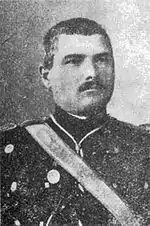Tudor Pamfile
Tudor Pamfile (11 June 1883 – 21 October 1923) was a Romanian writer.

Tudor Pamfile was born on 11 June 1883 in the village of Ţepu in Tecuci County (now in Galați County). He attended primary school and the gimnasium in Tecuci, and the transferred to the Military School in Bucharest. During his studies, he was befriended by Ioan Bianu, who introduced him to the literary circles of Bucharest. Upon graduation he was assigned to the Third Roşiori Regiment in Bârlad.
Tudor Pamfile's work, as a writer was significantly influenced by ethnographer and folklorist Simeon Florea Marian.[1] Pamfile himself is counted among prominent folklorists.[2] He, together with Arthur Gorovei, have been credited with being the first scholars to collect genuine Romanian folktales.[3]
Pamfile was editor of the magazines Ion Creangă and Miron Costin, both published in Bârlad. He also supported the magazine Freamătul initially published in Tecuci, but which moved to Bârlad. He wrote several ethnographic studies and contributed to the magazines Şezătoarea, Analele Academiei Române, Convorbiri Literare, Floarea darurilor, Însemnări literare, Lamura, Viața Românească, Viaţa literară şi artistică and Lumina poporului. With George Tutoveanu and Toma Chiricuţă, he was one of the founders of the literary society, Academia Bârlădeană.
Tudor Pamfile died on 21 October 1923 in Chişinău (now in Moldova)[4]
Works
- Jocuri de copii (3 volumes), Bucureşti, 1906–1909
- Cartea pentru tineret de la sate Bucureşti, 1907 (with Mihai Lupescu and L. Mrejeriu
- Povestire pe scurt despre neamul românesc - Bârlad, 1907
- Cimilituri româneşti - Bucureşti, 1908
- Craiul vremurilor (stories) - Vălenii de Munte, 1909
- Feţi frumoşi de odinioară (stories) - Bucureşti, 1910
- Industria casnică la Români. Trecutul şi starea ei de astăzi - Bucureşti, 1910
- Sărbătorile de vară la români "Summer Holidays of the Romanians" - Bucureşti, 1910
- Boli şi leacuri la oameni, vite şi păsări - Bucureşti, 1911
- Firişoare de aur (stories and legends) - Bucureşti, 1911
- Sfârşitul lumii după credinţele poporului român - Bârlad, 1911
- Culegere de colinde, cîntece de stea, vicleime, sorcove şi pluguşoare, întocmite pentru folosul tineretului ce urează la Crăciun şi Anul Nou - Bucureşti, 1912
- Culegere de ghicitori româneşti (cimilituri) - Bucureşti, 1912
- Agricoltura la români - Bucureşti, 1913
- Cântece de ţară - Bucureşti, 1913
- Povestea lumii de demult "Story of the World of Yore" - Bucureşti, 1913
- Cromatica poporului român (with Mihai Lupescu) - Bucureşti, 1914
- Diavolul învrăjbitor al lumii - Bucureşti, 1914
- Însemnări cu privire la moşia, satul şi biserica de la Strîmba din comuna Puieşti, judeţul Tutova (with V. C. Nicolau) - Bîrlad, 1914)
- Sărbătorile de toamnă şi postul Crăciunului - Bucureşti, 1914
- Sărbătorile la români. Crăciunul - Bucureşti, 1914
- Un tăciune şi-un cărbune. (stories) - Bucureşti, 1914
- Dragostea în datina tineretului român
- Pământul după credinţele poporului Român.
- Văzduhul după credinţele poporului Român (with Antoaneta Olteanu)
- Cerul şi podoabele lui, după credinţele poporului Român (with Antoaneta Olteanu)
- Mitologie românească
References
- Vulcanescu, Romulus; Simionescu, Paul (1973), "Some Special Sspects of Rumanian Ethnology", Rumanian Studies, 2: 199
- Costin, Claudia (2018), Folkloric Aspects of the Romanian Imaginary and Myth, 11, Cambridge Scholars Publishing, p. 227, ISBN 978-1-527-51473-7
- Dégh, Linda (1966), "Folklore and Ethnography in Rumania [and Comments and Reply]", Rumanian Studies, 7 (3): 307 JSTOR 2740055
- Università de Firenze - Tudor Pamfile